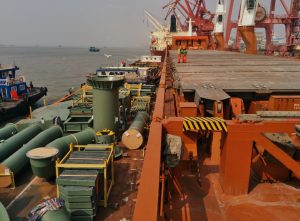International Freight for Heavy Industry
U.S. and China Lower Tariffs, Trade Expected to Rebound Quickly
U.S. and China Lower Tariffs, Trade Expected to Rebound Quickly
May 21, 2025—The United States and China have agreed to lower tariffs on each other’s goods, a move that could boost trade and dramatically change global shipping and logistics.

Starting May 14, the U.S. has cut tariffs on Chinese goods from 125% to 10%, establishing a new baseline minimum tariff of 30% on all Chinese exports to the U.S. In return, China is also lowering its retaliatory tariffs on U.S. goods from 125% to 10%. These reductions follow the 90-day pause for other countries announced in April.
According to a joint statement, both countries, “recognise that expanded trade, adherence to international market norms, and pursuit of market-based outcomes serve mutual economic interests”. They agreed to keep talking during the 90-day de-escalation. The agreement highlights the importance of facilitating world trade growth while still dealing with concerns raised by both sides.
Shipping Volumes Set to Surge
Ocean freight volumes are already reacting. In March, carriers accelerated inventory shipments from China to the U.S. in anticipation of steeper tariffs, resulting in a combined March-April volume increase of 11% compared to 2024. Notably, some of that growth came from countries like Vietnam and Thailand, rather than China.
Since the introduction of heightened tariffs, trade between China and the U.S. has dropped by more than 35%. Now, with tariffs lower again, shipping is expected to bounce back quickly as shippers may rush to front-load inventories ahead of the July and August deadlines, likely triggering an earlier-than-usual peak season.
However, the rapid surge in demand could pose challenges. Empty containers and vessels have been repositioned away from traditional China-U.S. lanes, and a sudden spike in shipments may result in tight capacity, equipment shortages, and shipping delays. A backlog of unshipped orders—now joined by a flood of new ones—could further strain global logistics networks.
MPP Sector Watches Closely
 Meanwhile, the multipurpose (MPP) shipping sector is cautiously assessing the policy shift’s implications for heavy-lift transport. While uncertainties remain, recent changes have exempted a substantial portion of the MPP fleet from newly announced U.S. port fees on Chinese-built vessels.
Meanwhile, the multipurpose (MPP) shipping sector is cautiously assessing the policy shift’s implications for heavy-lift transport. While uncertainties remain, recent changes have exempted a substantial portion of the MPP fleet from newly announced U.S. port fees on Chinese-built vessels.
Toepfer Transport’s Multipurpose Index suggests a level of resilience within the MPP and heavy-lift segments, with stakeholders adopting a wait-and-see approach as trade policy continues to evolve.
As negotiations continue during the agreed 90-day window, stakeholders across the supply chain will be watching closely for further developments—and preparing for what could be a turbulent but opportunistic period for global trade.
Freightplus is committed to chartering ships out of the UK, Europe and Asia to ensure continued supply to our valued customers. To stay up-to-date with the latest updates and other industry news, head to the Freightplus Newsroom or contact the Freightplus team.



